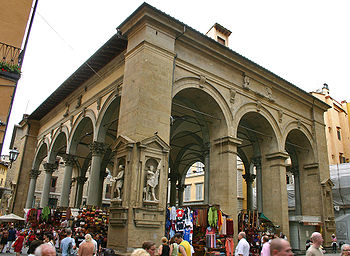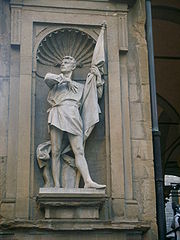
Loggia del Mercato Nuovo
Encyclopedia

Florence
Florence is the capital city of the Italian region of Tuscany and of the province of Florence. It is the most populous city in Tuscany, with approximately 370,000 inhabitants, expanding to over 1.5 million in the metropolitan area....
, Italy
Italy
Italy , officially the Italian Republic languages]] under the European Charter for Regional or Minority Languages. In each of these, Italy's official name is as follows:;;;;;;;;), is a unitary parliamentary republic in South-Central Europe. To the north it borders France, Switzerland, Austria and...
. It is so called to distinguish it from the Mercato vecchio (old market, [merˈkaːto ˈvɛkkio]) located in the area of today's Piazza della Repubblica
Piazza della Repubblica (Florence)
Piazza della Repubblica is a city square in Florence, Italy. It is on the site, first of the city's forum and then of the city's old ghetto, which was swept away during the city improvement works or Risanamento initiated during the brief period when Florence was the capital of a reunited Italy,...
.
History

Loggia
Loggia is the name given to an architectural feature, originally of Minoan design. They are often a gallery or corridor at ground level, sometimes higher, on the facade of a building and open to the air on one side, where it is supported by columns or pierced openings in the wall...
was built around the middle of the 16th century in the heart of the city, just a few steps from the Ponte Vecchio
Ponte Vecchio
The Ponte Vecchio is a Medieval stone closed-spandrel segmental arch bridge over the Arno River, in Florence, Italy, noted for still having shops built along it, as was once common. Butchers initially occupied the shops; the present tenants are jewellers, art dealers and souvenir sellers...
. Initially, it was intended for the sale of silk and luxury goods and then for the famous straw hats, but today mainly leather goods and souvenirs are sold.
In the corner niches statues of famous Florentines were intended to be placed, but only three were made during the 18th century: Michele di Lando
Michele di Lando
Michele di Lando was the first leader of the Ciompi Revolt in Florence that started in 1378.-Background:Michele di Lando was the son of a woman named Simona who was a vegetable seller in Florence. Michele himself was a wool carder....
, Giovanni Villani
Giovanni Villani
Giovanni Villani was an Italian banker, official, diplomat and chronicler from Florence who wrote the Nuova Cronica on the history of Florence. He was a leading statesman of Florence but later gained an unsavory reputation and served time in prison as a result of the bankruptcy of a trading and...
, and Bernardo Cennini
Bernardo Cennini
Bernardo Cennini was an Italian goldsmith, sculptor and early printer of Florence. As a sculptor he was among the assistants to Lorenzo Ghiberti in the long project producing the second pair of doors— the Doors of Paradise— for the Battistero di San Giovanni. He produced the first book printed at...
.
The focal point of the loggia is the Fontana del Porcellino (fonˈtaːna del ˌportʃelˈliːno, "fountain of the piglet"), actually a copy of a bronze wild boar by Pietro Tacca
Pietro Tacca
Pietro Tacca was an Italian sculptor, who was the chief pupil and follower of Giambologna. Tacca began in a Mannerist style and worked in the Baroque style during his maturity.-Biography:...
from the sixteenth century; the original can be found at Palazzo Pitti
Palazzo Pitti
The Palazzo Pitti , in English sometimes called the Pitti Palace, is a vast mainly Renaissance palace in Florence, Italy. It is situated on the south side of the River Arno, a short distance from the Ponte Vecchio...
. Popular tradition has it that rubbing the nose brings fortune, so over time, the statue has acquired a certain shine in that spot. Visitors are encouraged to place a coin in the mouth of the boar after rubbing its nose, and superstition implies that the wish will be granted if the offering tumbles through the grate whence the water flows. The slope of the grate is such that most coins do fall through, and are collected by the city.
Pietra dello scandalo
Another oddity of the place is the so-called pietra dello scandalo (ˈpjɛːtra dello ˈskandalo, the "stone of the shame"), a round spot marked in bicoloured marble at the centre of the loggiaLoggia
Loggia is the name given to an architectural feature, originally of Minoan design. They are often a gallery or corridor at ground level, sometimes higher, on the facade of a building and open to the air on one side, where it is supported by columns or pierced openings in the wall...
, which is only visible when no sales stalls are there. The design reproduces one of the wheels of a medieval Carroccio
Carroccio
A Carroccio was a four-wheeled war altar, mounting a large vexillum standard, drawn by oxen, used by the medieval republics of Italy. It was a rectangular platform on which the standard of the city and an altar were erected; priests held services on the altar before the battle, and the trumpeters...
, symbol of the Florentine republic
History of Florence
Florence is a major historical city in Italy, distinguished as one of the most outstanding economical, cultural, political and artistic centres in the peninsula from the late Middle Ages to the Renaissance.-Prehistoric evidence:...
, on which the city's standard was hoisted daily. The Carroccio was placed on this spot and Florentine troops met around it before every battle.
The spot was later chosen for another purpose, whence its alternative name pietra dell'acculata (ˈpjɛːtra delˌlakkuˈlaːta, approximately "the stone of the bum punishment"). During the Renaissance, the punishment of insolvent debtors included being chained to a post on this spot and then paddled repeatedly on the naked buttocks. The popular expression stare col culo a terra ("to have one's ass on the ground") and the word sculo (a dialectal word for "misfortune") may have originated from this practice.
See also
- Mercato Vecchio
- Mercato Centrale (Firenze)
- Mercato di Sant'Ambrogio

